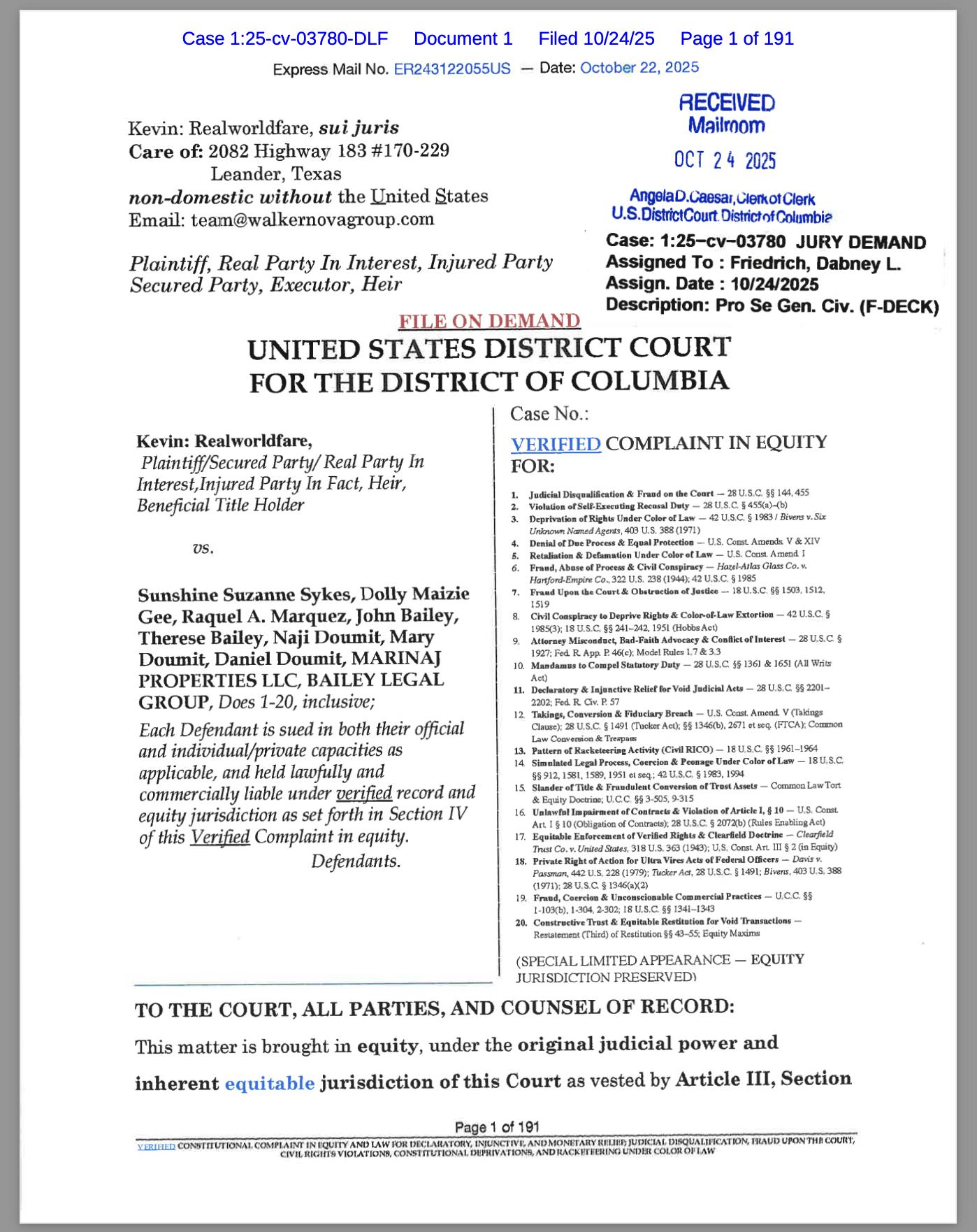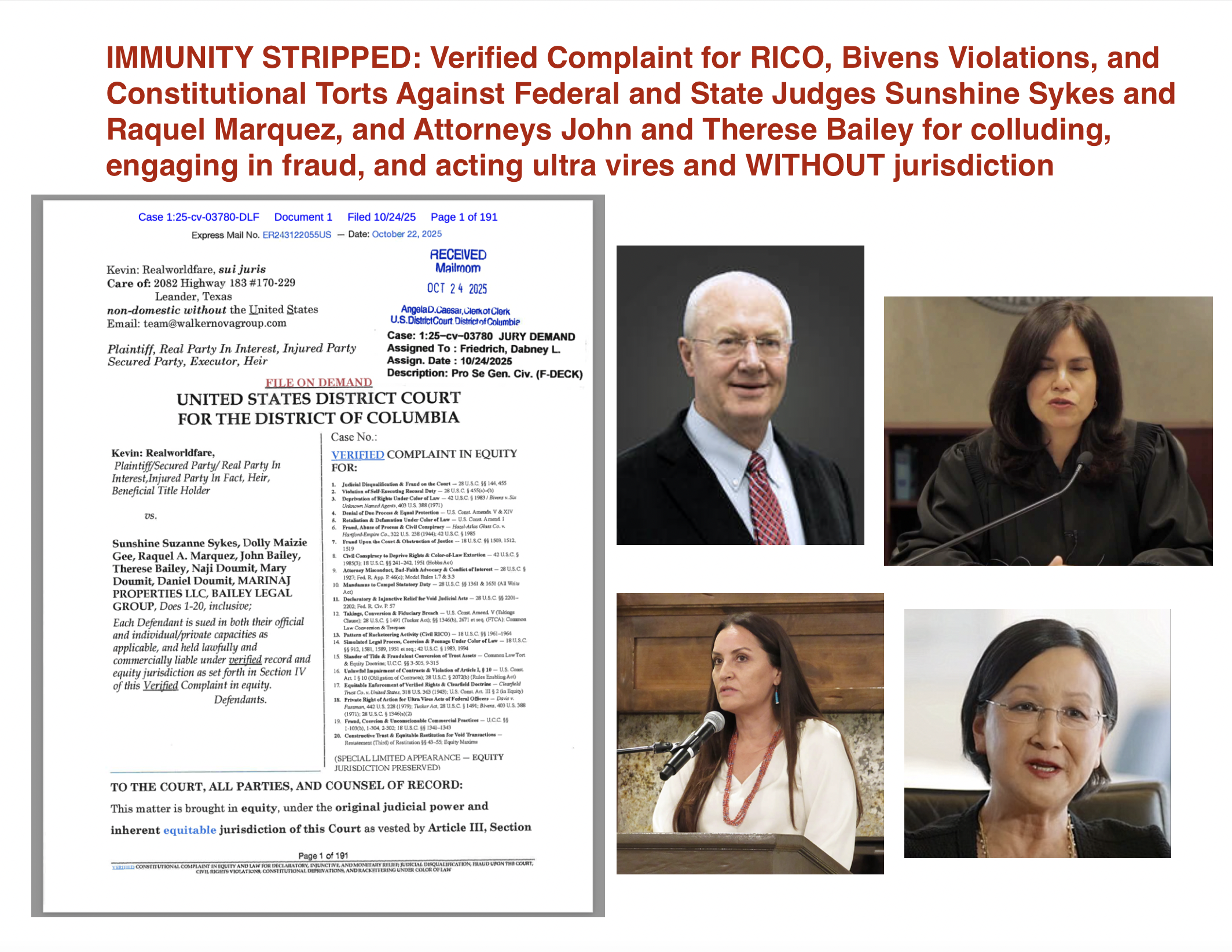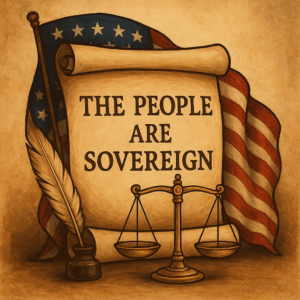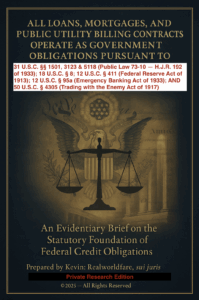I. INTRODUCTION: A FEDERAL AND STATE JUDICIAL CONSPIRACY NOW UNDER ACTIVE FEDERAL SCRUTINY
The illusion of judicial immunity is shattering.
Two sitting judges — Sunshine Suzanne Sykes, a federal judge of the U.S. District Court for the Central District of California, and Raquel A. Marquez, a state judge of the California Superior Court — now stand exposed as key operatives in an interlocking RICO enterprise that weaponized the courts to perpetrate fraud, theft, and constitutional treason under color of law.
These are not baseless accusations. They are the verified, sworn, and unrebutted facts of record now before the U.S. District Court for the District of Columbia, where a Bivens and RICO lawsuit has been filed, demanding a full trial by jury to prosecute what may be one of the most egregious acts of judicial collusion in modern U.S. history.
At the center of this criminal web are The Bailey Legal Group, Naji Doumit, and Marinaj Properties LLC — private actors who conspired with Sykes and Marquez to forge a multi-jurisdictional racket designed to strip private citizens of property, silence verified affidavits, and obstruct lawful process through fraudulent orders, fabricated dismissals, and suppression of evidence.
Together, they operated a commercial pipeline of corruption disguised as judicial administration — where “orders” were not rulings but commercial instruments of theft, and “hearings” were not adjudications but pre-scripted performances to launder pre-determined outcomes through a captured judiciary.
This is not conjecture or rhetoric — it is documented fact, verified through court filings, certified mail receipts, unrebutted affidavits, and the judges’ own dockets.
Both Sykes and Marquez continued acting after verified disqualification, in open defiance of 28 U.S.C. §§ 144 and 455, issuing void orders, fabricating jurisdiction, and coercing representation to maintain control over proceedings they were legally and constitutionally barred from touching.
Their pattern of conduct — mirrored, coordinated, and deliberate — constitutes judicial racketeering, obstruction of justice, and commercial fraud under color of office.
What began as civil litigation has now evolved into a federal criminal exposure of systemic corruption — where both a federal judge and a state judge, working in tandem with private law firms and corporate beneficiaries, are being called to answer for acts of conspiracy, extortion, and constitutional deprivation.
The case is no longer a question of “judicial error.” It is a criminal operation masquerading as jurisprudence, a betrayal of public trust so severe that even the Constitution itself demands redress.
And that redress is now before the District of Columbia — the seat of the Republic’s federal authority — where the People will have the final say, before a jury, under oath, in the light of day.
II. FEDERAL SUPERVISORY JURISDICTION, VENUE, AND THE COLLAPSE OF IMMUNITY
1. The District of Columbia: The Supervisory Jurisdiction Over Federal Actors
By law and constitutional design, the U.S. District Court for the District of Columbia stands as the supervisory forum for all federal officers, judges, and agents who act outside their delegated authority.
Article III of the Constitution vests judicial power in courts created by Congress; Congress in turn centralized oversight of federal officials and agencies within the District of Columbia to ensure accountability when those officials violate the Constitution, commit fraud, or act in excess of their jurisdiction.
The District of Columbia Code § 11-501 and 28 U.S.C. § 1391(e) confirm venue and jurisdiction for civil actions against federal officers acting under color of law, while 28 U.S.C. § 1331 grants subject-matter jurisdiction for federal-question claims arising under the Constitution and the laws of the United States.
No other venue carries this level of oversight. It is the court of original and supervisory jurisdiction for federal misconduct, constitutional torts, and administrative treason.
Therefore, the D.C. District Court is the only lawful and proper forum for adjudicating the acts of Judge Sunshine Suzanne Sykes—a federal officer who operated ultra vires, beyond the scope of judicial authority—and for holding her co-conspirators liable as private participants in a federal racketeering enterprise.
2. How Immunity Fails Under Bivens, Bradley, Clearfield, and the Hobbs Act
The doctrines that once insulated public officers now function as the very instruments that expose them.
-
Bivens v. Six Unknown Named Agents, 403 U.S. 388 (1971):
The Supreme Court held that federal officials who violate constitutional rights under color of office are personally liable for damages. Judicial office offers no protection once the conduct leaves the bounds of lawful adjudication. Sykes’ coercion, suppression of evidence, and post-disqualification rulings are textbook Bivens violations. -
Bradley v. Fisher, 80 U.S. (13 Wall.) 335 (1872):
Even the 19th-century Court distinguished between acts within jurisdiction and those taken in the clear absence of it. A judge acting without jurisdiction “is liable to respond in damages to the injured party.”
Both Sykes and Marquez acted without jurisdiction after verified disqualification and removal. Their subsequent orders are void ab initio, and every protection they might have claimed under Bradley collapses by its own language. -
Clearfield Trust Co. v. United States, 318 U.S. 363 (1943):
When the government or its agents enter the realm of private or commercial conduct, they act as private persons, stripped of sovereign immunity.
By coercing representation, colluding with private law firms, and protecting fraudulent real-estate transactions, Sykes and Marquez acted as commercial operators, not judges. Under Clearfield, they now stand as private wrongdoers, personally liable for every dollar, deed, and signature tainted by their fraud. -
The Hobbs Act, 18 U.S.C. § 1951:
The use of “official right” or color of authority to obtain property, advantage, or compliance is federal extortion. When a judge leverages her bench to compel representation, suppress filings, or enforce void orders for a favored party, that is Hobbs-Act extortion under color of office, punishable as a federal felony.
Together these authorities create an unbroken chain of liability:
-
Bivens removes civil immunity.
-
Bradley denies judicial protection where jurisdiction is absent.
-
Clearfield eliminates sovereign immunity when the act is commercial.
-
The Hobbs Act criminalizes the coercion that results.
No doctrine remains to hide behind. The shield of immunity has been replaced by the sword of liability.
3. Sykes and the RICO Enterprise Acted Without Jurisdiction or Authority
Every ruling, dismissal, and writ issued after verified disqualification was ultra vires—beyond the court’s constitutional power.
When Sykes continued to rule after being lawfully challenged under 28 U.S.C. §§ 144 and 455, she ceased to function as a judge and became a private usurper committing acts of fraud, obstruction, and deprivation of rights under color of law.
Her accomplices—Marquez, the Baileys, Naji Doumit, and Marinaj Properties LLC—aided and abetted that fraud by enforcing, benefiting from, and laundering the results of those void acts.
Under 18 U.S.C. § 241 (conspiracy against rights) and § 242 (deprivation of rights under color of law), their coordinated conduct constitutes a federal criminal conspiracy.
Under 18 U.S.C. § 1962(c) (RICO), their combined use of courts, law firms, and false filings satisfies every element of racketeering activity.
And under 28 U.S.C. § 2072(b), no rule or procedure can abridge the substantive rights now invoked against them.
They did not misstep; they mutinied. They abandoned the law they swore to uphold and attempted to operate a private syndicate under its name. The result is jurisdictional vacuum—no authority, no immunity, no defense.
4. The Legal and Moral Bottom Line
The District of Columbia holds supervisory jurisdiction precisely for this purpose: to rein in federal officers who mistake power for immunity.
It is here, under the watch of Article III and the jury of the People, that the question will be settled once and for all—whether a judge can commit fraud and still claim to be a judge.
The record leaves no doubt:
Sykes, Marquez, and their RICO partners acted without jurisdiction, without lawful authority, and without immunity.
Their badges of office are not shields; they are evidence tags.
And under the laws they ignored—Bivens, Bradley, Clearfield, the Hobbs Act, and the Constitution itself—their reckoning will be public, permanent, and absolute.

IMMUNITY STRIPPED: Verified Complaint for RICO, Bivens Violations, and Constitutional Torts Against Federal and State Judges Sunshine Sykes and Raquel Marquez, and Attorneys John and Therese Bailey for colluding, engaging in fraud, and acting ultra vires and WITHOUT jurisdiction
III. THE HEART OF THE FRAUD: VOID ORDERS AND ULTRA VIRES ACTS
When a judge is disqualified, the law is not ambiguous — it is absolute.
Every act that follows is null, void, and legally nonexistent. This is not a matter of judicial discretion or interpretation; it is the bedrock principle of due process and jurisdiction. Once disqualification occurs, the judge ceases to exist in a judicial capacity. Any further act taken from the bench is not a ruling — it is a criminal impersonation of authority.
Yet, Sunshine Suzanne Sykes and Raquel A. Marquez knowingly violated this black-letter rule, continuing to issue orders, remands, dismissals, and writs of possession even after verified disqualification and federal removal had stripped them of all lawful power to act. These were not judicial acts — they were acts of usurpation, performed under color of law to conceal fraud, retaliate against lawful litigants, and preserve the illusion of jurisdiction that no longer existed.
The Ninth Circuit’s own controlling precedent destroys any pretense of legality:
“A judge who continues to act after disqualification acts in clear absence of all jurisdiction.”
— United States v. Sibla, 624 F.2d 864 (9th Cir. 1980); Studley v. United States, 783 F.2d 934 (9th Cir. 1986)
Those words are not advisory — they are mandatory. They carry the full force of federal law. When Sykes and Marquez chose to ignore them, they crossed the line from judicial conduct to criminal conduct. What followed was not a case proceeding, but a simulated legal process, a staged performance designed to deceive the public record and to legitimize theft and deprivation of rights under the pretense of law.
Every order entered after disqualification is void ab initio — not voidable, not subject to appeal, but a nullity, carrying no legal effect whatsoever. The moment those orders were signed, they became felonious instruments, evidence of a willful conspiracy to defraud and obstruct justice.
Under constitutional law and the Canons of Judicial Conduct, their actions meet every element of fraud upon the court, official misconduct, and treason against the Constitution they swore to uphold.
By persisting in this charade, Judge Raquel Marquez became the state-level enforcer of a federal obstruction conspiracy, aiding in the illegal dispossession of property already under federal jurisdiction and subject to active litigation. She acted as the operational extension of Sykes’ federal misconduct — providing the muscle and signature of state authority to execute what was, in reality, a coordinated theft of property and due process.
This was not error.
It was intentional lawlessness, executed under the mask of judicial process.
Sykes and Marquez both knew the rules. They chose to break them. They knowingly acted without jurisdiction, a fact that no amount of procedural theater can erase. In doing so, they committed fraud, obstruction, and constitutional treason — not as judges, but as private individuals operating an unlawful enterprise under color of office.
Their orders are not law. They are evidence. Evidence of corruption, conspiracy, and criminal abuse of power — and those acts will now be judged not by their peers on the bench, but by a jury of the People.
IV. THE COLLUSION: SYKES, MARQUEZ, THE BAILEYS, NAJI DOUMIT, AND MARINAJ PROPERTIES LLC
At the epicenter of this judicial conspiracy lies The Bailey Legal Group, operated by John and Therese Bailey — two bar-licensed attorneys who committed the ultimate betrayal of due process: appearing as both defendants and attorneys of record in the very same case.
This was not mere negligence or poor judgment — it was calculated procedural fraud, collapsing the adversarial process into a self-dealing defense cartel. The Baileys effectively controlled both sides of the litigation, manufacturing the illusion of opposition while quietly engineering outcomes favorable to their own financial and professional interests.
Despite verified notice of this irreconcilable conflict, Judge Sunshine Suzanne Sykes not only ignored it — she ratified it. From the federal bench, she permitted this grotesque breach of ethics to proceed unchallenged, converting her courtroom into a protection racket for corrupt attorneys and extinguishing every pretense of impartial adjudication.
Her state-level counterpart, Judge Raquel A. Marquez, then enforced the fruits of that fraud — honoring void trustee’s deeds and executing eviction writs derived from jurisdictionally defective proceedings. Marquez’s actions were not independent errors; they were the implementation arm of a coordinated scheme, providing the appearance of lawful enforcement to orders that were, in reality, void ab initio.
Meanwhile, Naji Doumit and Marinaj Properties LLC acted as the commercial beneficiaries and front-end operators of the enterprise — the “bag men” of the judiciary’s financial corruption.
These private corporate actors knowingly trafficked in stolen title, attempting to launder property rights derived from a fraudulent and non-existent sale, while concealing the jurisdictional defects that rendered every transaction null.
Their conduct constitutes classic RICO predicate acts — including wire fraud, mail fraud, and deprivation of rights under color of law, in direct violation of 18 U.S.C. §§ 241, 242, and 1962(c).
Together, these individuals and entities operated as a single, continuous criminal enterprise, using the robes of judicial authority and the veneer of legal process to perpetrate what amounts to state-sponsored theft.
They suppressed verified affidavits, ignored dispositive evidence, and obstructed UCC filings that exposed the fraud — turning the federal and state benches into a dual-platform racketeering system. The judiciary itself became the weapon, the law a disguise, and the courtroom a crime scene.
This was not litigation.
It was organized crime under the color of judicial process, a systematic defilement of the Constitution and the rule of law. The result is now unmistakable: two judges, a law firm, and their corporate accomplices functioning as a multi-tier RICO syndicate, operating behind the mask of public office and professional license — caught in the act, and now facing judgment in the only court that still matters: the one before the People.
V. COERCION AND CIVIL-RIGHTS VIOLATIONS UNDER COLOR OF LAW
What occurred under the gavel of Sunshine Suzanne Sykes and Raquel A. Marquez was not adjudication—it was state-sponsored coercion masquerading as law.
From the federal bench, Judge Sykes attempted to strip Kevin: Realworldfare of his guaranteed right of self-representation, forcing him toward BAR-licensed counsel in direct defiance of 28 U.S.C. § 1654 and the Supreme Court’s ruling in Faretta v. California, 422 U.S. 806 (1975). She knew the law. She violated it deliberately. This was not guidance; it was compulsion, a demand that the citizen surrender constitutional autonomy to a private guild whose loyalty lies not with the People but with the courts that feed it.
At the state level, Judge Marquez mirrored that corruption—recognizing only BAR appearances, refusing verified equitable filings, and facilitating the unlawful seizure of private property already under federal protection. She acted as the enforcement arm of Sykes’s federal misconduct, weaponizing the state court to give the illusion of legitimacy to orders already void for lack of jurisdiction.
These were not judicial acts. They were commercial acts—transactions executed to preserve the BAR monopoly and sustain a closed-market protection racket inside the courts. Every coerced signature, every stricken affidavit, every ignored filing represents a commerce-driven deprivation of rights executed under color of law.
Such conduct annihilates the foundation of liberty. It violates:
-
The First Amendment right to petition government for redress of grievances;
-
The Fifth Amendment guarantee of due process and property protection; and
-
The Sixth Amendment right of self-representation.
Each violation is independently actionable under Bivens v. Six Unknown Named Agents, 403 U.S. 388 (1971)—where federal officials who abuse their authority are held personally liable for constitutional torts.
And under the Clearfield Doctrine (Clearfield Trust Co. v. United States, 318 U.S. 363 (1943)), once government actors depart from lawful authority and engage in private or commercial behavior, sovereign immunity evaporates. At that moment, they stand not as judges, but as private criminals, fully exposed to prosecution and personal liability for fraud, extortion, and deprivation of rights under color of law.
Sykes and Marquez chose that path. They crossed from governance into commerce, from adjudication into exploitation. Their robes no longer shield them—they cloak indictable acts. What they called “procedure” was coercion. What they called “judicial discretion” was constitutional sabotage.
They did not administer justice; they sold it—and in doing so, forfeited every protection the law could ever afford them.
VI. THE CURRENT STATUS: D.C. DISTRICT COURT — TRIAL BY JURY DEMANDED
The conspiracy has outgrown its hiding places.
It has crossed state borders, pierced the illusion of judicial independence, and now stands before the federal seat of power in Washington, D.C.
A Verified Bivens and RICO Complaint has been filed in the U.S. District Court for the District of Columbia, naming Sunshine Suzanne Sykes, Raquel A. Marquez, The Bailey Legal Group, Naji Doumit, and Marinaj Properties LLC as defendants. Each is now called to answer—not as untouchable officials or corporate elites—but as individual participants in a criminal enterprise that subverted justice, extorted rights, and trafficked in fraudulent judgments under the color of law.
The filing demands more than token remedies:
-
Compensatory and punitive damages for every act of fraud, coercion, and deprivation of rights;
-
Vacatur of all void orders, writs, and judgments, each one a paper monument to lawlessness;
-
Formal referral for judicial, bar, and criminal discipline at every level; and
-
Above all, a public trial by jury—where evidence will not be buried under procedure and where the People, not the bench, will decide the truth.
The District of Columbia is the only forum suited for this reckoning. It is the jurisdiction that governs those who have weaponized their offices against the Constitution itself. Within that court, federal and state actors alike will stand stripped of immunity and stripped of pretense, forced to confront the record they tried to erase.
This case is no longer a dispute; it is a living indictment of systemic corruption—a forensic exposure of how two judges, a law firm, and their commercial proxies turned the judicial process into an instrument of organized crime.
Their crimes are documented, their signatures authenticated, their violations unrebutted. What remains is judgment—not from colleagues, not from political overseers, but from a jury of ordinary Americans who still recognize the difference between law and tyranny.
When that verdict comes, it will not merely punish the guilty; it will mark the death of judicial impunity and the rebirth of accountability under the rule of law.
VII. WHY THIS MATTERS: THE END OF UNTOUCHABLE JUDICIAL IMMUNITY
For half a century, corrupt judges have hidden behind the fiction of judicial immunity — a judicially manufactured shield that was never intended to sanctify treachery. It was designed to protect good-faith adjudication, not to harbor felons in robes or to transform public office into an instrument of commercial theft. The bench has been treated like a throne, the robe like armor, and the oath of office like a ceremonial lie. But that era is ending — violently, lawfully, and publicly.
Judicial immunity was never absolute. It is forfeited the instant a judge crosses the line from adjudication into personal interest, retaliation, or commerce. At that moment, the judge ceases to function as a judicial officer and becomes a private actor committing felonies under color of office. The Supreme Court drew this boundary in Forrester v. White, 484 U.S. 219 (1988):
“Judicial immunity is not a license to engage in corruption, fraud, or administrative tyranny.”
Sykes and Marquez trampled that principle.
They ignored verified disqualification, coerced representation, enforced void orders, and conspired with private litigants to perpetuate theft of property and denial of due process. Those are not judicial acts — they are criminal acts, stripped of jurisdiction and protection. Every unlawful order and every retaliatory ruling was a commercial instrument of fraud.
The law is not silent on this. When public officers abandon lawful authority, they lose the cloak of sovereignty:
-
Under the Clearfield Doctrine (Clearfield Trust Co. v. United States, 318 U.S. 363 (1943)), once a government actor steps into the realm of private or commercial conduct, sovereign immunity evaporates. The officer becomes a private party, personally liable for their fraud, coercion, and misrepresentation.
-
Under Bivens v. Six Unknown Named Agents, 403 U.S. 388 (1971), federal officials who violate constitutional rights under color of law become personally accountable for civil damages.
-
Under Bradley v. Fisher, 80 U.S. (13 Wall.) 335 (1872), even the earliest Supreme Court precedent distinguishes between acts performed within jurisdiction and those in clear absence of it — the latter receiving no immunity whatsoever.
-
And under the Hobbs Act, 18 U.S.C. § 1951, any use of official power to obtain property, advantage, or consent through intimidation, threat, or color of office constitutes extortion, a federal felony.
By those standards — statutory, constitutional, and moral — Sykes and Marquez stand fully exposed. Their actions fall squarely outside the protective boundaries of law and squarely within the definitions of fraud, extortion, conspiracy, and racketeering under 18 U.S.C. §§ 241, 242, 1341, 1343, 1962, and 1951.
They are not immune. They are indictable.
Every fraudulent order issued after disqualification, every coerced signature, every suppression of evidence constitutes an act of Hobbs Act extortion, civil rights deprivation under color of law, and commercial fraud against the People. These are not procedural errors — they are constitutional felonies, executed through the abuse of a public trust.
This case now before the U.S. District Court for the District of Columbia is not merely a lawsuit; it is the execution of accountability long deferred. It is the first true test of whether the judiciary can cleanse itself or whether the People must do it through the jury — the last lawful tribunal not yet captured by the system it must judge.
For the first time, the architects of this judicial cartel — Sykes, Marquez, the Baileys, Naji Doumit, and Marinaj Properties LLC — will be forced to face the Constitution they violated. They will be stripped of privilege, stripped of illusion, and confronted with evidence under oath — not before fellow conspirators in chambers, but before a jury of the sovereign People whose trust they betrayed.
This is not about property, procedure, or paperwork — it is about the survival of lawful government itself.
If a judge can commit fraud and escape consequence, then law is theater and justice is dead.
But if a citizen can pierce the veil, invoke Bivens, enforce Clearfield, and expose judicial crime through evidence and verified record, then the Republic still breathes.
That is why this matters.
Because this time, the robe is not protection — it is evidence.
And when the People render judgment, it will not be lenient, it will be final.
VIII. CONCLUSION: THE BEGINNING OF THE END FOR INSTITUTIONALIZED FRAUD
This case is not born of vengeance — it is born of truth.
It tears the veil off a system that for too long has confused authority with honesty and procedure with justice.
It exposes how judges, attorneys, and corporate agents conspired to silence verified evidence, hijack jurisdiction, and seize private property under the counterfeit banner of law.
What has been uncovered is not a rogue error — it is institutionalized corruption, refined through decades of impunity and arrogance.
That age is ending.
The filing now before the U.S. District Court for the District of Columbia is more than a lawsuit; it is a national reckoning.
It calls by name those who believed themselves untouchable: Sunshine Suzanne Sykes, Raquel A. Marquez, John and Therese Bailey, Naji Doumit, and Marinaj Properties LLC.
Each must now answer — not in secret chambers or sealed conferences — but before a jury of the People, where truth cannot be filtered through privilege or protected by robe or license.
The question before that jury is disarmingly simple:
Can a judge, cloaked in office, commit fraud and escape accountability?
The evidence says no.
The law says no.
And the People, at long last, will have the chance to say no in a verdict that will echo through every courthouse in America.
When the record is laid bare in Washington, D.C., it will not merely determine liability; it will decide the future of judicial integrity in the United States.
Because if this enterprise can be exposed, prosecuted, and defeated in open court, then judicial immunity dies where accountability begins, and the rule of law is reborn.
This is the line in the sand — and the defendants have crossed it.
Now comes the reckoning.




